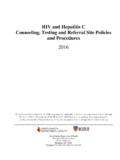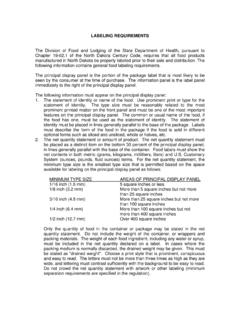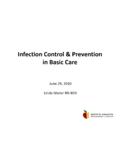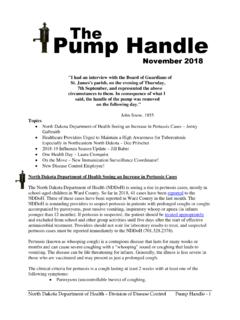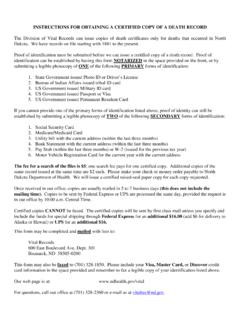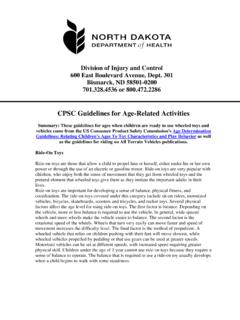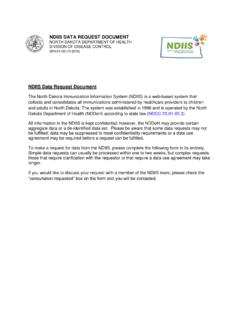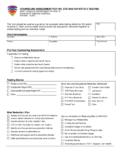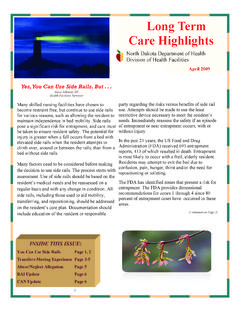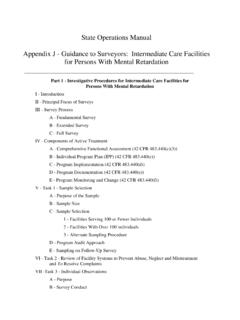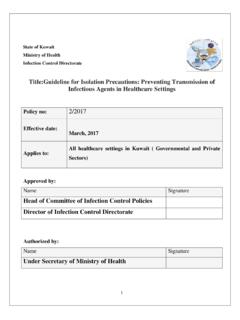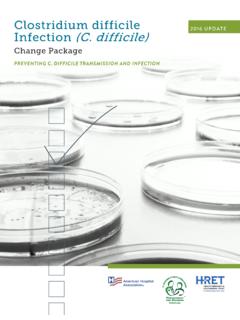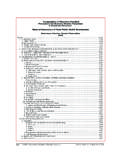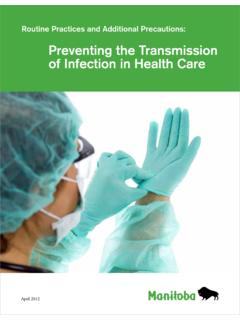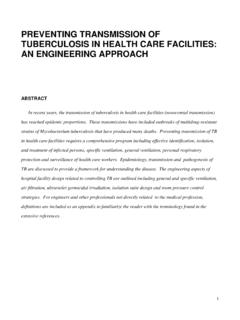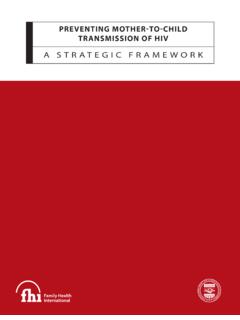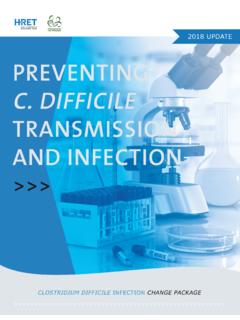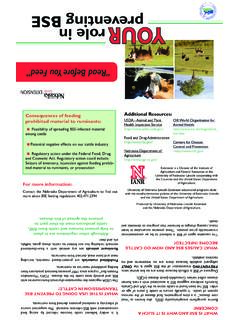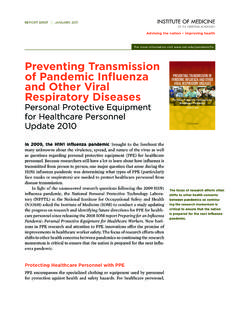Transcription of Managing Multidrug-Resistant Organisms (MDROs) in Long ...
1 Managing Multidrug-Resistant Organisms (MDROs) in Long-term Care Facilities: Practical Tips for preventing Transmission Nimalie D. Stone, MD/MS. Ambulatory and Long-term Care Team Division of Healthcare Quality Promotion December 15, 2011. National Center for Emerging and Zoonotic Infectious Diseases Division of Healthcare Quality Promotion Presentation Outline Describe the growing problem of Multidrug-Resistant Organisms (MDROs) in long-term care facilities (LTCF). Understand the basics about Multidrug-Resistant Organisms (MDROs) and how they emerge and spread in healthcare facilities Understand the strategies to address the emergence/spread of Multidrug-Resistant Organisms (MDROs) in LTC. Provide examples of applying these prevention strategies to address specific HAI's such as C. difficile and Carbapenem- resistant Enterobacteriacea (CRE).
2 Changing population in nursing homes million residents received care in 15, 956 certified NH/SNF in the US in 2008. Acute care hospitals are the primary source of new admissions From 1999 to 2008. 16% decrease in the number of nursing home beds/. 1000 residents of US population;. 10% increase in the number of residents cared for in LTC. Increasing proportion of individuals under the age of 65 are receiving care in LTCFs ( in 2008). Growing post-acute care population as custodial care shifts to assisted-living Nursing Home Compendium 2009, CMS. Growing complexity in the nursing home resident population Increasing post-acute care population Growing medical complexity and care needs Increasing exposure to devices, Community-based Acute care wounds and antibiotics care Dynamic movement across healthcare settings High prevalence of multidrug - Tranquil Gardens.
3 Nursing Home resistant Organisms Long-term care Basics on bacteria Gram Stain Gram Stain Positive Negative (purple) (pink/red). Bacteria have different characteristics that allow us to identify them in the lab Growth patterns, structure of the cell We use these characteristics to develop antibiotics Common types of bacteria Gram positive Most are cocci, round bacteria . Streptococcus, Staphylococcus, Enterococcus Clostridium difficile (C. diff ) is a Gram positive rod Gram negative Most are baccili, rod-shaped bacteria . Enterobacteriaceae: E coli, Klebsiella, Enterobacter , Proteus Pseudomonas Normal bacterial carriage People have bacteria living in and on us all the time Some live on our skin, some in our nose and throats, others in our bowels Our bodies need these bacteria to help us Some digest food/nutrients, others block bad bugs These colonizing bacteria aren't harmful Only bacteria that invade our system and cause illness need to be treated Antibiotics 101.
4 Antibiotics are drugs that treat and kill bacteria They are grouped into classes based on their structure and activity Narrow-spectrum target a few specific bacteria Broad-spectrum can kill a wide variety of bacteria Infection prevention programs track certain bug- drug combinations for evidence that the bacteria is getting resistant Bacteria with resistance can cause patients to have more severe, costly infections which are harder to treat Antibiotic Classes Penicillins Examples: Penicillin, amoxicillin, ampicillin, methicillin Penicillins can be combined with a drug to help them overcome certain bacterial resistance Amoxicillin + Clavulante = Augmentin;. Piperacillin + tazobactam = Zosyn Cephalosporins (cousins to penicillins). 1st generation (more gram positive activity): Cephalexin, Cefazolin 3rd/4th generation (more gram negative): Ceftriaxone, Ceftazidime Antibiotic Classes (cont).
5 Carbapenems Examples: Imipenem, meropenem, ertapenem Extremely broad-spectrum, among the most powerful antibiotics we currently Miscellaneous drugs with only gram positive activity: Vancomycin, linezolid, daptomycin Vancomycin is the primary treatment for Methicillin- resistant Staphylococcus aureus (MRSA). Oral vancomycin is ONLY used to treat C difficile;. IV Vancomycin must be used to treat all other infections Enterococci that develop resistance to Vancomycin are called Vancomycin- resistant enterococci (VRE). Antibiotic Classes (cont). Fluoroquinolones 1st generation (Ciprofloxacin) mostly gram neg activity, often used for UTI treatment 2nd/3rd gen (Levofloxacin/Moxifloxacin) have broader activity, can cover Streptococcus pneumoniae and other respiratory/sinus bacteria Aminoglycosides Examples: Gentamicin, Tobramycin, Amikacin Excellent gram negative drugs especially for urinary tract Aren't used as much because can be toxic to the kidneys, need to be monitored when used Antibiotic Classes (cont).
6 Miscellaneous drugs Trimethoprim/Sulfamethoxazole (Bactrim): Considered by many to be narrow spectrum, but has Gram neg and Gram pos activity, used to treat UTIs, also good for MRSA skin infections Azithromycin ( Z-pack ): Also considered more narrow spectrum, good for respiratory/sinus infections Metronidazole (Flagyl): One of the main treatments for C. difficile infections Mechanisms of antibiotic resistance Production of proteins that destroy antibiotics Beta-lactamases Carbapenemases Change their cell structure so antibiotics can't bind and block their function Reduce their antibiotic exposure Pump drugs out Increase cell barriers to keep drug out Defining multidrug -resistance resistant to treatment by several antibiotics from unrelated classes Sometimes just one key drug resistance will define an important mdro , for example, Methicillin- resistance in Staph aureus Sometimes bacteria acquire resistance to several classes, often seen in gram negative rods Cephalosporin-resistance is a big concern in bacteria like E coli/Klebsiella which often cause UTIs Pseudomonas will be resistant to fluoroquinolones, penicillins, cephalosporins, and carbapenems ABC's of MDROs Bacteria Abbrev.
7 Antibiotic Resistance Staphylococcus MRSA Methicillin- resistant aureus Enterococcus VRE Vancomycin- resistant (faecalis/faecium). Enterobacteriaceae CRE Carbapenem- resistant (E coli/Klebsiella, etc) (KPC). Pseudomonas/ MDR Many drug classes Acinetobacter Case of an emerging mdro . Lab examined all the Acinetobacter cultured from people at 4 local hospitals over 5 years Classified as hospital-associated, NH-associated, or community-associated Wanted to see how antibiotic resistance emerged in this community multidrug -resistance emerged quickly Over 5 year period, antibiotic resistance increased dramatically In the last 2 years of the study pan- resistant bacteria emerged Culture sources: Respiratory secretions (56%); Wounds (22%);. Urine (12%). Sengstock DM, et al. Clin Infect Dis. 2010 50(12): 1611-1616. Healthcare facilities are the source of MDROs All the highly resistant bacteria were coming from patients in the hospital or those in the nursing homes NOT from people living at home Sengstock DM, et al.
8 Clin Infect Dis. 2010 50(12): 1611-1616. Critical message about care transitions Sengstock DM, et al. Clin Infect Dis. 2010 50(12): 1611-1616. MDROs in the healthcare setting DEVELOPMENT. Antibiotic pressure Mostcommon predictor of antibiotic resistance is prior exposure Device utilization Biofilm formation on central lines, urinary catheters, etc. SPREAD. Patient to patient transmission via healthcare workers Environmental / equipment contamination Role of colonization pressure on acquisition Resistance from antibiotic pressure At first most of the bacteria can be killed by the drug (green). But, once they are wiped out, the resistant bugs take over (red). Antibiotic use drives resistance Johnson et al. Am J. Med. 2008; 121: 876-84. Biofilm formation on device surfaces Biofilm: Ancollection of bacteria within a sticky film that forms a community on the surface of a device Biofilm on an indwelling catheter Tenke, P et al.
9 World J. Urol. 2006; 24: 13-20. Resistance develops within biofilms Bacteria within a biofilm are grow every differently from those floating around freely These changes in their growth make our antibiotics less effective Antibiotics can't penetrate the biofilm to get to the bacteria This leads to much less drug available to treat the bugs Bacteria within the biofilm can talk to each other and share the traits that allow some to be resistant Over time more and more of them become resistant as well Tenke, P et al. World J. Urol. 2006; 24: 13-20. Bacterial contamination of HCW hands prior to hand hygiene in a LTCF. Gram negative bacteria were the most common bugs cultured from hands of staff Most Gram neg. bacteria live in the bowls or colonize the urine!!! Mody L, et al. InfectContHospEpi. 2003; 24: 165-71. Hand Hygiene Most effective and least costly means of preventing the transmission of MDROs Yet, compliance still ranges between ~30- 60%.
10 Alcohol-based hand rub improves compliance and decontamination Mody L, et al. InfectContHospEpi. 2003; 24: 165-71. Decreased MRSA infections associated with increased hand hygiene compliance Pittet, D et 2000;356:1307-12. The invisible reservoir of MDROs X marks the locations where VRE was isolated in this room Image from Abstract: The Risk of Hand and Glove Contamination after Contact with a VRE (+) Patient Environment. Hayden M, ICAAC, 2001, Chicago, IL. Slide courtesy of Teresa Fox, GA Div PH. Duration of environmental contamination by MDROs Colonization pressure on risk of acquisition Colonization pressure: Presence of other mdro . carriers on a unit will increase the risk of mdro . acquisition to a non-carrier close by Studies have demonstrated the impact of colonization pressure on acquisition of MRSA, VRE. and CDI. Both asymptomatic carriers (colonized) and actively infected individuals can be a source for transmission (spread) on a unit Williams VR et al.
